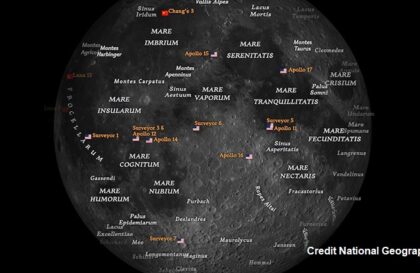Wet Moon, jade rabbit, Cheshire Moon, and other manifestations of the Earth’s satellite in people’s eyes.
The illusion known as the “man on the moon” is widespread in various cultures worldwide and appears to be related to magnetic dust left behind by ancient lava eruptions on the moon.
This dust became the source of lunar swirls – bright and mysterious patterns on the moon’s rocky surface that often appear as faces and other shapes during a full moon. NASA has known about the existence of these whirlpools for decades and described them as “the cream in the coffee,” but the reason for their formation remained unknown for a long time.
At the same time, the view of the Moon changes depending on the observer’s location on Earth since the top and bottom of this celestial sphere are relative concepts. This difference is especially noticeable regarding the so-called “man on the moon.” Although this idea has no scientific basis, many people see features on the surface of the full Moon, such as eyes, a smile, and a nose, which are formed by light and dark spots of craters.
The ‘man in the Moon’ illusion (real image of Moon, left; artist’s impression of illusion, right) is recognised by traditions across the globe. A new study suggests lunar swirls, critical markings on the Moon that help create the illusion, are caused by magnetic dust left over by ancient lava. Credit
If you observe the Moon from the Southern Hemisphere, it appears to be smiling, but from the Northern Hemisphere, it looks like a “little man” is preoccupied and unhappy.
People of different cultures often see additional images and symbolism in the dark spots of the Moon. The Chinese, for example, traditionally associate them with the moon rabbit. According to their folklore, the moon rabbit works hard using a mortar and pestle to create the elixir of life for the moon goddess, Chang’e. In Japan and Korea, rabbits are also seen, but they are believed to be involved in beating rice cake dough.
The moon may soon have a new visitor in the form of the Indian spacecraft Chandrayaan-2 and its lander Vikram. Credit: Anupam Nath/AP/TT
In ancient Chinese poetry, “Golden Rabbit” and “Jade Rabbit” were used interchangeably to refer to the Moon. The American Indians also had legends about the moon rabbit. In Hawaii, they paid attention to the wet Moon, which sometimes looks like a bowl with a crescent, reminiscent of the appearance of the Cheshire cat from Lewis Carroll’s fairy tale “Alice in Wonderland.” This phenomenon is often called the “Cheshire Moon”.
John Reed of the Central Arkansas Astronomical Society captured this photo on February 11, 2013. He gave it the title Cheshire Cat Moon. Credit: Earth Sky/author John Reed
Another fascinating optical illusion is the perception of the Moon when it hangs low on the horizon and appears significantly larger than when it is high in the sky. Two hypotheses explain this phenomenon.
The first hypothesis states that people often need to be better judges of vertical distances because we perceive the sky as a flattened dome rather than a sphere. As a result, we mistakenly perceive the Moon to be smaller and closer to us when it is at its highest point above the horizon.
The second hypothesis states that we judge distances by comparing objects in the foreground and background. When the Moon is high in the sky, and there are no nearby objects for comparison, it appears smaller to us because there is no reference point for estimating its size.
Thus, this optical illusion is explained by our way of perceiving vertical distances and comparing the sizes of objects against the background.
Sometimes, you can observe a unique phenomenon: a lunar halo – a ring around the Moon. It is caused by the refraction of light in ice crystals in cirrus clouds.
Banner image: Vito Technology, Inc.
Image credit:
https://starwalk.space
https://www.dailymail.co.uk
https://tidningensyre.se
https://earthsky.org






